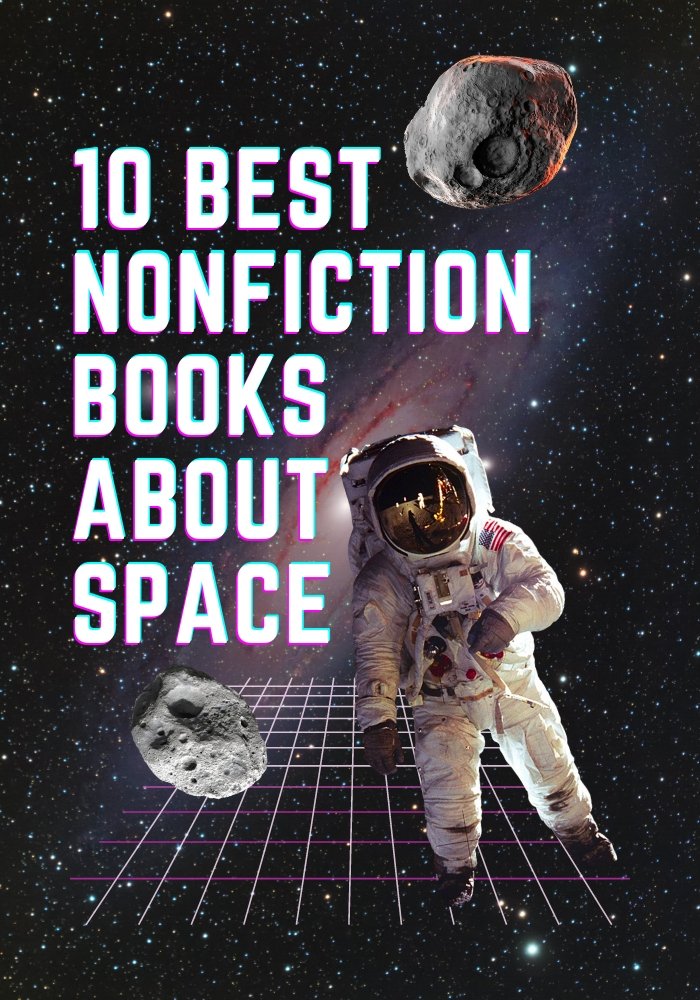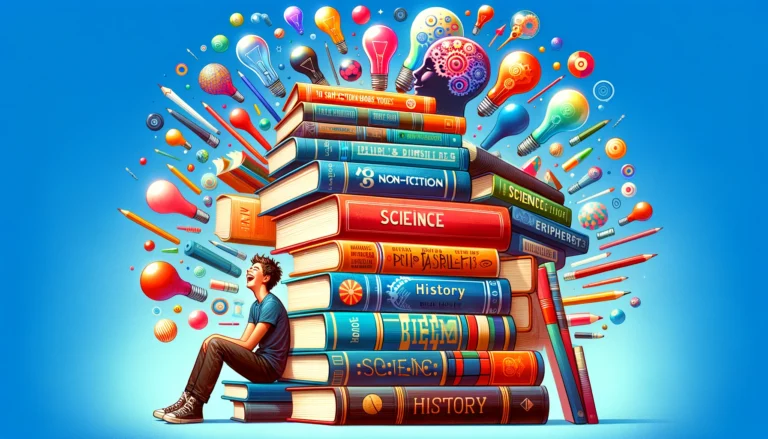Introduction
Welcome to a practical exploration of space through the lens of ten remarkable nonfiction books. These selections inform and inspire, covering the vastness of space, significant astronautic achievements, and pivotal discoveries that redefine our view of the universe. These books cater to a variety of interests, whether you’re a student, a professional, or simply intrigued by the night sky. Presenting grounded, factual narratives, they offer enlightening and engaging insights into the cosmos. This guide aims to equip you with knowledge and insights, serving as a bridge between earthly life and celestial phenomena. Dive into a concise look at each book, highlighting what sets them apart and why they’re essential reads for anyone eager to expand their understanding of our universe.
1. “Cosmos” by Carl Sagan

In “Cosmos,” Carl Sagan combines scientific insight with narrative flair to explore the universe. While the book delves into the grandeur of space, it also reflects on our relationship with the universe. Sagan’s writing, rich with detailed examples and compelling arguments, challenges us to expand our understanding of both the cosmos and our place within it. Each chapter builds on this theme, using specific scientific phenomena to illustrate larger existential questions.
Although Sagan’s enthusiasm for astronomy is clear, the book occasionally might feel overwhelming to readers new to this subject due to its intricate descriptions. Moreover, while Sagan’s prose is generally engaging, some passages might benefit from a more streamlined explanation, especially when delving into complex astronomical concepts.
“Cosmos” serves not just as an introduction to space but as an invitation to ponder our philosophical and scientific perspectives. Sagan’s approach blends detailed scientific explanations with reflective, occasionally poetic language, inviting a broad audience to engage with astronomy. His skillful narrative does more than convey information, it encourages a deeper appreciation of the universe, though some might find the poetic elements at odds with the scientific discussions. This balance between detailed exposition and broad philosophical questioning is what sets “Cosmos” apart, making it a valuable read for both seasoned astronomers and curious newcomers alike.
2. “A Brief History of Time” by Stephen Hawking

Stephen Hawking’s “A Brief History of Time” is a cornerstone in popular science literature, making intricate physics topics accessible to a broad audience. This book adeptly clarifies subjects like black holes and the Big Bang, employing layman’s terms that engage readers without a scientific background. For example, Hawking’s discussion on black holes is particularly effective, blending scientific rigor with enough simplicity to be understood by those unfamiliar with the topic.
However, the book sometimes slips into technical language that may perplex novices. Sections dealing with quantum mechanics, while informative, could benefit from more contextual grounding to aid comprehension.
The narrative strength of the book lies in its ability to pose profound questions about the universe while providing personal insights, highlighting Hawking’s unique capacity to captivate diverse readers. Yet, it is crucial to point out that some parts of the book might require external resources for full understanding.
“A Brief History of Time” is commendable for its educational value and its ability to spark curiosity about the universe. It effectively bridges the gap between advanced scientific theories and everyday comprehension. To further enhance its reach, a slight reduction in technical jargon and the inclusion of more contextual explanations would make the more challenging theories accessible to all readers.
3. “The Right Stuff” by Tom Wolfe

Tom Wolfe’s “The Right Stuff” provides an intimate look at the first American astronauts, blending detailed narrative with deep personal insights. Wolfe vividly illustrates the astronauts’ intense training, such as the centrifuge test that simulates the gravitational forces during launch. His description, “the man in the capsule is being shaken until his teeth rattle,” brings the physical strain vividly to life, underlining the bravery required to face such challenges.
However, the book sometimes crosses into exaggeration. Phrases like “sheer human courage” could be moderated to “remarkable courage” to avoid overstatement without diminishing the astronauts’ achievements. Including more viewpoints from the support team could also offer a fuller picture of the space missions.
Wolfe’s skill in portraying the astronauts’ fears and resolve is exemplified in the launch scenes, where personal reflections are interwoven with technical details, creating a palpable tension. While his narrative captures the drama effectively, a more straightforward recounting in places could enhance the book’s historical authenticity.
Overall, “The Right Stuff” is an evocative account of America’s early space endeavors, rich in personal and technical detail. Wolfe’s narrative brings us closer to understanding the astronauts, although a toned-down approach to dramatic language could make the story even more compelling.
4. “Pale Blue Dot: A Vision of the Human Future in Space” by Carl Sagan

In “Pale Blue Dot,” Carl Sagan eloquently extends the themes from “Cosmos,” focusing on humanity’s potential in the cosmos. Centered around the iconic Voyager 1 image of Earth, Sagan uses this photograph to underscore our planet’s vulnerability in the vast universe. He argues that space exploration is crucial for our species’ survival and progress, presenting this stance through compelling rhetoric and detailed scientific insights.
However, Sagan’s optimism about colonizing other planets sometimes appears overly idealistic without sufficient consideration of the real barriers. For example, he glosses over the immense technological advances and ethical debates necessary for such endeavors, areas that would benefit from a deeper examination to balance his optimistic projections.
Sagan’s prose is rich with metaphors, notably describing Earth as “the pale blue dot we call home,” which effectively draws readers into a reflective state about our environmental stewardship and cosmic destiny. Yet, this poetic approach could be balanced with more precise language to strengthen his scientific arguments. For instance, while discussing the potential for life on other planets, a clearer presentation of the current research and technological limitations would provide a more realistic perspective.
“Pale Blue Dot” is a stimulating read that successfully makes complex concepts accessible and motivational. To enhance its impact, incorporating direct quotes from the book, such as Sagan’s reflection on Earth as “a lonely speck in the great enveloping cosmic dark,” could vividly anchor his philosophical insights. Overall, while the book inspires a visionary look at our future in space, it would gain from a more critical examination of the challenges that lie ahead.
5. “Packing for Mars: The Curious Science of Life in the Void” by Mary Roach

In “Packing for Mars,” Mary Roach immediately immerses readers in the bizarre reality of space hygiene, explaining how astronauts handle necessities like zero-gravity toilets. She uses specific, often humorous anecdotes, such as astronauts contending with floating waste particles, to vividly illustrate these odd scenarios. This direct, relatable storytelling captivates readers, making the complexities of space unexpectedly accessible.
Roach’s narrative is particularly compelling because of her attention to the human experience. She delves into the psychological toll of isolation, sharing poignant accounts from astronauts who describe their emotional highs and lows during missions. These personal stories, drawn from interviews and diaries, make the psychological challenges palpable and relatable.
By weaving scientific facts with engaging human stories, Roach breaks down the astronaut experience into elements that resonate with her audience. She explores how the minutiae of daily space life from sleeping tethered in a bag to personal hygiene impact an astronaut’s mental and physical state.
Ending on a strong note, Roach doesn’t just inform, she transforms how we perceive the entirety of space travel. Her book is a must-read not only for its rich insights but also for its ability to make the unimaginable aspects of astronaut life thoroughly understandable and deeply human. This approach is why “Packing for Mars” is an essential addition to space literature, providing a fresh lens through which we can view our universe.
6. “The Universe in a Nutshell” by Stephen Hawking

In “The Universe in a Nutshell,” Stephen Hawking challenges readers with profound visual and textual explanations that make complex cosmic concepts feel within reach. Rather than merely offering diagrams, his book uses visuals like the spacetime diagram to vividly depict how massive objects distort the space around them. This particular diagram doesn’t just show, it tells guiding the reader through the visualization with step-by-step annotations that clarify the gravity of such phenomena.
Hawking’s gift for clear communication shines through in his analogies, such as comparing the effect of gravity on spacetime to a bowling ball on a stretched bedsheet. This analogy not only simplifies the abstract but also sparks visual understanding among those unfamiliar with scientific jargon.
The book’s journey through the cosmos is particularly compelling due to Hawking’s methodical pacing, which carefully layers foundational concepts before introducing more complex ideas. This pedagogical approach keeps the narrative accessible and progressively builds the reader’s confidence in tackling sophisticated theories.
Hawking’s integration of narrative and visuals effectively demystifies subjects that might otherwise seem daunting. For example, his discussion on quantum mechanics is interspersed with clear illustrations and thought experiments that break down barriers to understanding.
Each chapter serves to expand the reader’s knowledge by linking theoretical implications to observable phenomena, which instills a sense of wonder and encourages further inquiry. Hawking’s approach is particularly effective as it combines factual rigor with speculative inquiry, inviting readers to ponder what lies beyond the edges of current understanding.
7. “Astrophysics for People in a Hurry” by Neil deGrasse Tyson

Astrophysics for People in a Hurry’ condenses the expansive principles of astrophysics into Neil deGrasse Tyson’s concise, accessible explanations. This book removes the jargon and complex mathematical barriers often associated with the field, making the fascinating aspects of the cosmos more inviting to novices. Tyson employs his characteristic enthusiasm to illuminate foundational concepts, encouraging curiosity without the overwhelming details typical of more advanced texts. This work is particularly suited for those curious about astrophysical phenomena but intimidated by traditional academic treatments. Instead of dense exposition, Tyson opts for a narrative that sparks interest with practical examples and relatable analogies, making it a primer for those seeking a casual acquaintance with astrophysics.
8. “Endurance: A Year in Space, A Lifetime of Discovery” by Scott Kelly

Scott Kelly’s memoir, ‘Endurance: A Year in Space, A Lifetime of Discovery,’ effectively narrates his remarkable year on the International Space Station, blending scientific exploration with deep personal introspection. The text vividly illustrates the profound isolation and relational tensions that define long-term space missions, adding a relatable human element to a high-tech saga.
However, Kelly’s detailed forays into astronautics, while informative, may prove dense for those not acquainted with space jargon, sometimes eclipsing the more personal aspects of his narrative. Furthermore, the book suffers from uneven pacing, the dense technical descriptions disrupt the narrative rhythm, starkly contrasting with engaging personal reflections that detail the emotional challenges of his experience.
Ultimately, while ‘Endurance’ is a powerful ode to human resilience, the fluctuating focus can fragment the reader’s engagement, slightly marring an otherwise thrilling exploration of both outer space and inner fortitude.
9. “The Martian Chronicles” by Ray Bradbury

Ray Bradbury’s ‘The Martian Chronicles’ is a cornerstone of science fiction literature, renowned for sparking interest in Mars colonization through its series of connected stories. This work delves into themes such as the implications of human expansion and the ethical quandaries of colonization. However, the book’s format of linked narratives can sometimes feel disjointed, with varying levels of engagement and depth across the stories.
Bradbury’s prose is undeniably evocative, painting the stark yet beautiful Martian landscapes and the emotional turmoil of its characters. Yet, the term ‘visionary’ is not without its caveats. The speculation on technology and society feels both prescient and occasionally dated, reflecting the era’s optimism and fears but sometimes missing the mark on future scientific realities.
While Bradbury skillfully merges poignant human stories with futuristic scenarios, some narratives may come across as overly moralistic, potentially oversimplifying complex issues. Despite these shortcomings, ‘The Martian Chronicles’ remains influential, providing valuable insights into human nature and our longing for the unknown. Its impact on both literature and space enthusiasm is undeniable, yet its episodic approach might not resonate with all readers, making its ‘timeless’ label debatable.
10. “Hidden Figures: The American Dream and the Untold Story of the Black Women Mathematicians Who Helped Win the Space Race” by Margot Lee Shetterly

Margot Lee Shetterly’s ‘Hidden Figures’ skillfully brings to light the significant yet underrepresented contributions of African American women mathematicians at NASA during the Space Race. The book excels in setting historical context and shedding light on a crucial aspect of history that has often been omitted.
However, Shetterly’s narrative sometimes delves too deeply into technical descriptions of space missions, such as the intricacies of orbital mechanics in several chapters, which may slow down the pace for readers less familiar with aerospace terminology. While her detailed portrayal of Katherine Johnson, Dorothy Vaughan, Mary Jackson, and others highlights their monumental achievements against societal barriers, the narrative repetition of these themes can occasionally feel redundant, particularly in the middle sections where the focus on daily routines feels overemphasized.
Shetterly’s prose aims to humanize these iconic figures through personal anecdotes and a detailed recounting of their challenges. However, the tone sometimes shifts towards an instructional style, particularly in sections where the broader implications of civil rights are discussed, which might distract from the personal stories at the heart of the book.
The book is framed as a tribute, which is its strength but also a limitation. The narrative tends towards adulation, which can overshadow a more analytical exploration of the women’s contributions to NASA and the Space Race. A more nuanced approach could have provided a balanced view of their scientific work alongside their personal stories.
Overall, ‘Hidden Figures’ is a pivotal work that corrects a significant omission in the history of space exploration, but it would benefit from a more balanced narrative approach to enhance engagement and reduce predictability. Sections that detail the training and preparation for space missions, for example, could be condensed to maintain narrative momentum and focus more on the personal impacts and broader societal changes these women influenced.
Conclusion
This collection of ten books offers varied insights into space exploration and its profound impact on our understanding of the universe. While each author, from Carl Sagan with his philosophical reflections to the narratives about the unsung women of NASA, attempts to broaden our view of the cosmos, the books vary in the depth and accessibility of their content.
These works prompt us to expand our understanding and challenge conventional perspectives on space. For example, they explore the personal and professional sacrifices of astronauts and scientists, bringing a human element to the high-stakes environment of space exploration. However, while these books are intended to be inspirational, some may find the scientific details in certain volumes overwhelming or the personal narratives too narrowly focused.
By engaging with these texts, readers can appreciate the blend of resilience, creativity, and curiosity that drives human exploration. Yet, it should be noted that the effectiveness of their storytelling and scientific explanations varies. Some books excel in narrative drive and emotional connection, while others struggle with pacing or technical opacity.
These narratives do more than just recount historical achievements, they invite readers to consider their own place in the ongoing quest for knowledge. However, potential readers should be prepared for the uneven quality among the works. As a starting point for those captivated by the night sky, these books offer gateways to deeper knowledge, though not all will resonate equally.
In summary, while this collection serves as a useful primer on the challenges and triumphs of space exploration, it also exemplifies the uneven nature of popular science writing. Readers are encouraged to critically engage with these works, recognizing both their contributions and limitations in the broader discourse on space.






